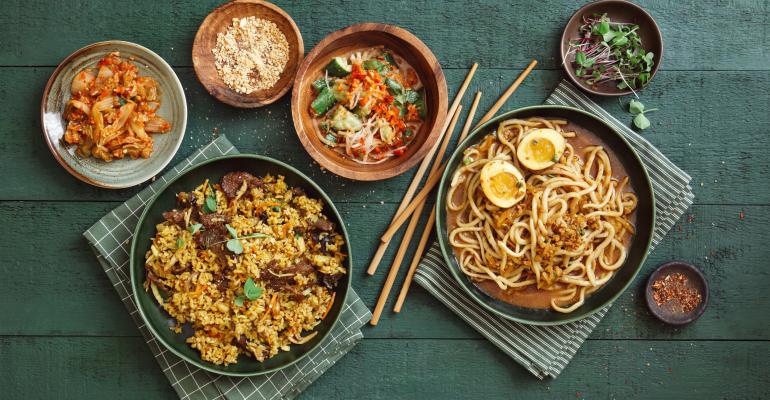Sponsored by Kikkoman
As American menus continue to go global with influences from all over the world, one cuisine keeps rising to the top: Japanese.
Asian is the most ordered ethnic food among consumers in most foodservice segments.[1] Japanese restaurants—and foods like sushi, teriyaki and tempura—have, of course, been part of the foodservice landscape for decades. But in recent years, the ramen craze helped open the door to a world of traditional Japanese flavors and ingredients.
Ramen and other bowl dishes have been among the fastest-growing examples of Asian cuisine in the U.S., according to Yelp’s 2023 State of the Industry Report. The report found that ramen restaurant openings were up 45% in the year ended in April 2023, compared to the previous year, and openings of noodle concepts were up 40%. In addition, Japanese restaurant openings were up 20% in that time, and sushi restaurant openings rose by 13%.
Now, food trend forecasters are pointing to a phenomenon they’re calling “Japan
The Japanese chef Nobu Matsuhisa, for example, blends Japanese and Peruvian cuisines in his Nobu restaurants, reflecting a culinary style known as Nikkei cuisine, which is also being championed at Causita (Los Angeles), Kaiyo (San Francisco), and Pacha Nikei (Houston). Meanwhile, leading-edge Restaurants like Ryla (LA) and Ethel’s Fancy are reinventing Japanese culinary ideas in fresh, contemporary ways.
Here's a look at how you can tap into consumers’ love of Japanese flavors.
Bring on the Asian bowls
Research firm Datassential reported that bowls have surged on U.S. menus: By 2020, 35.7% of restaurants offered bowl dishes, up from 29.7% in 2016, according to this Kikkoman infographic. In addition to ramen, other increasingly popular Asian bowl dishes include poke and bibimbap.
Kikkoman can help. The company offers two labor-saving
Try tempura
Tempura is another traditional Japanese dish that operators can readily incorporate into their menus to evoke the influence of authentic Japanese cuisine, says Chef Mutsuko Soma of Kamonegi.
“Tempura frying is an easy way to introduce Japanese techniques to any dish,” he says. You can make tempura batter in-house, or buy a pre
Incorporate Japanese
Some traditional Japanese ingredients are also growing on restaurant menus in the U.S., including yuzu, often described as a Japanese lime, and shiso, an herb in the mint family that is popular in Japanese cooking.
Add umami to anything
Perhaps no other flavor represents Japanese cuisine more than the umami flavor
Soy sauce, in particular, offers an easy way for chefs to incorporate into their menus the umami flavor that customers crave, in addition to offering the on-trend attribute of being a fermented food product. Traditionally brewed
Chef Soma notes that soy sauce also provides a vehicle to reinforce the authenticity of Japanese dishes on the menu.
Chef Soma’s advice about soy sauce comes as research shows the value that consumers place on this condiment.
Trust the brand consumers love
According to a Kikkoman survey[3], 63% of restaurant patrons surveyed said they can taste the difference between their preferred soy sauce brand and other brands, and more than half (58%) of restaurant patrons surveyed believe that the brand of soy sauce is important when dining out.
In addition,
In fact, Kikkoman
For more sauce inspiration, recipe ideas, and other information to help you leverage the flavors that Asian sauces can bring to your menu, visit https://kikkomanusa.com/foodservice/.
[1] Technomic, Inc. 2018 Ethnic Food and Beverage Consumer Trend Report, 2018
[2] Kim Severson, “How will we eat in 2023” New York Times, June 20, 2023
[3] From April 11-21, 2023, Kikkoman conducted an online survey among 1,000 soy sauce consumers who were aware of either Kikkoman or other soy sauce brands and who have dined out or ordered from an Asian restaurant in the past month. The margin of error is +/-3%.
[4]Based on the U.S sales data during the 52-week period ending 8/12/23.

